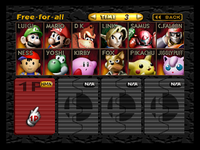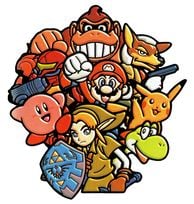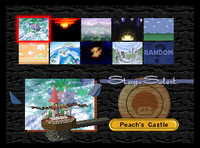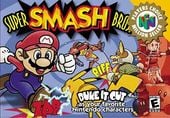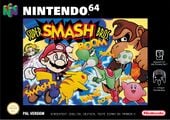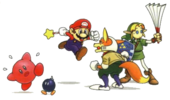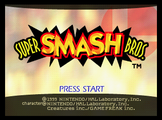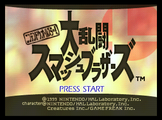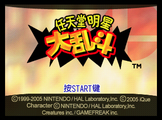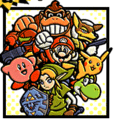Super Smash Bros.: Difference between revisions
m (byte saving links. Adjusted table to not be 100% width) |
mNo edit summary |
||
| Line 19: | Line 19: | ||
The game released in Japan on January 21st, 1999, in North America on April 26th, 1999 and in Europe on November 19th, 1999 for the [[Nintendo 64]]. Subsequently, it released on the [[iQue Player]] in China on November 15, 2005. The [[Wii]]'s Virtual Console version released on January 20th, 2009 in Japan, a day before its 10-year anniversary and later that year in Europe and North America. However, because the Wii Shop Channel ceased operations on January 30th, 2019 (with the ability to add Wii Points permanently removed on March 26, 2018), the only way to currently obtain the game is by purchasing a used copy or playing it on an emulator. | The game released in Japan on January 21st, 1999, in North America on April 26th, 1999 and in Europe on November 19th, 1999 for the [[Nintendo 64]]. Subsequently, it released on the [[iQue Player]] in China on November 15, 2005. The [[Wii]]'s Virtual Console version released on January 20th, 2009 in Japan, a day before its 10-year anniversary and later that year in Europe and North America. However, because the Wii Shop Channel ceased operations on January 30th, 2019 (with the ability to add Wii Points permanently removed on March 26, 2018), the only way to currently obtain the game is by purchasing a used copy or playing it on an emulator. | ||
''Super Smash Bros.'' received positive reviews, with most praise going to its multiplayer mode, while its single-player mode received criticism. The game has sold 5 million units worldwide as of 2001, making it the fifth best-selling Nintendo 64 game of all time. | ''Super Smash Bros.'' received positive reviews, with most praise going to its multiplayer mode, while its single-player mode received some criticism. The game has sold 5 million units worldwide as of 2001, making it the fifth best-selling Nintendo 64 game of all time. | ||
==Opening movie== | ==Opening movie== | ||
Revision as of 16:14, February 2, 2021
| “ | Something's gone wrong in the happy-go-lucky world of Nintendo! | ” |
| —North American commercial | ||
| Super Smash Bros. | |
|---|---|
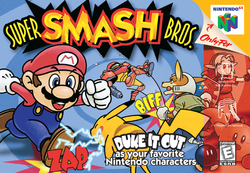
| |
| Developer(s) | HAL Laboratory, Inc. |
| Publisher(s) | Nintendo |
| Designer(s) | Masahiro Sakurai |
| Released | Nintendo 64: iQue Player: Virtual Console: |
| Genre(s) | Fighting game Platforming |
| Mode(s) | Single-player, multiplayer (2-4) |
| Ratings | ESRB: E PEGI: 7 OFLC: G8+ |
| Platform(s) | Nintendo 64 iQue Player Virtual Console |
| Media | 128 megabit cartridge Flash Card (China) |
Super Smash Bros. (also called Super Smash Bros. 64, Smash 64 or Super Smash Bros. N64), released in Japan as Nintendo All Star! Dairantō Smash Brothers (ニンテンドウオールスター! 大乱闘スマッシュブラザーズ, Nintendo All-Star! Great Fray Smash Brothers), often shortened to "SSB", retronymously "Smash 64" or "SSB64", is the first game of the Super Smash Bros. series.
The game released in Japan on January 21st, 1999, in North America on April 26th, 1999 and in Europe on November 19th, 1999 for the Nintendo 64. Subsequently, it released on the iQue Player in China on November 15, 2005. The Wii's Virtual Console version released on January 20th, 2009 in Japan, a day before its 10-year anniversary and later that year in Europe and North America. However, because the Wii Shop Channel ceased operations on January 30th, 2019 (with the ability to add Wii Points permanently removed on March 26, 2018), the only way to currently obtain the game is by purchasing a used copy or playing it on an emulator.
Super Smash Bros. received positive reviews, with most praise going to its multiplayer mode, while its single-player mode received some criticism. The game has sold 5 million units worldwide as of 2001, making it the fifth best-selling Nintendo 64 game of all time.
Opening movie
The opening movie in Super Smash Bros., unlike later games in the Super Smash Bros. series, completely lacks pre-rendered footage. It instead opts to use the game engine to render everything in real-time.
When the opening movie starts, two random starter characters are placed by Master Hand on top of a desk, which shortly transitions to a scene resembling Peach's Castle. This process is repeated every time the opening movie is played.
As the opening movie concludes, the figures of the four unlockable characters are flashed against a white background. If a character hasn't been unlocked, they will simply be shown as a silhouette; conversely, they will be revealed once unlocked.
Finally, the opening movie segues into the title screen, a trend which would be followed by future installments, along with the announcer calling out the game's title.
Characters
There are twelve playable characters in Super Smash Bros., eight of whom are available from the start and four of whom are unlockable.
The highest amount of character slots are given to the Mario and Pokémon universes with each receiving two fighters: Mario alongside his brother Luigi, and Pikachu and Jigglypuff respectively, with the latter characters in both universes being unlockable.
Two more slots are given to reoccurring Mario characters Donkey Kong and Yoshi as starting fighters from their sub-universes of the same names, Donkey Kong and Yoshi.
The other starter characters are Link, Samus, Kirby and Fox from The Legend of Zelda, Metroid, Kirby and Star Fox universes, respectively. The final remaining characters, as with Luigi and Jigglypuff, are unlockable: Ness of EarthBound and Captain Falcon of F-Zero.
| Starters (8) | |||
|---|---|---|---|
 Mario |
 Yoshi |
 Donkey Kong |
 Link |
 Samus |
 Kirby |
 Fox |
 Pikachu |
| Unlockables (4) | |||
 Luigi |
 Jigglypuff |
 Captain Falcon |
 Ness |
Stages
The game features nine stages derived from each character's universe, exceptions being EarthBound and F-Zero. While most universes receive a single stage, Mario uniquely has two instead: Peach's Castle and the only unlockable stage in the game, Mushroom Kingdom. Besides of that, the other stages consist of Congo Jungle, Hyrule Castle, Planet Zebes, Yoshi's Island, Dream Land, Sector Z, and Saffron City from Donkey Kong, The Legend of Zelda, Metroid, Yoshi, Kirby, Star Fox, and Pokémon respectively.
Versus mode stages
| Versus mode | ||||
|---|---|---|---|---|
 Peach's Castle |
 Congo Jungle |
 Hyrule Castle |
 Planet Zebes |
 Mushroom Kingdom |
 Yoshi's Island |
 Dream Land |
 Sector Z |
 Saffron City |
|
Shown in bold, Mushroom Kingdom is the only unlockable stage in Super Smash Bros.
1P Game-only stages
| 1P Game-only | ||||||
|---|---|---|---|---|---|---|
 Break the Targets |
 Board the Platforms |
 Race to the Finish |
 Yoshi's Island* |
 Meta Crystal |
 Battlefield |
 Final Destination |
These stages only appear in the 1P Game.
*The 1P Game-only Yoshi's Island lacks clouds and has closer blast zones.
Non-playable stages
| Non-playable | ||
|---|---|---|
 Small |
 New |
 Tutorial Stage |
These stages cannot be unlocked or played on in any way without hacking.
Modes
1-Player
Multiplayer
Tournament play
Unlike its successors, Super Smash Bros. never enjoyed a large professional competitive scene in North America. However, interest in the game has been renewed in recent years with the popularity of its sequels. Players can play Super Smash Bros. online through Kaillera using the Project64k emulator. Every year, there are more and more Super Smash Bros. tournaments due to an influx of new players. Most tournaments are paired with Melee events and most (offline) SSB tournaments are located in California, Canada, New Jersey or Peru.
The standard tournament rules differ little from those of Melee. The most common standard tournament rules are as follows:
- The required number of victories to win are generally the best of 3 matches; the only exceptions are finals, in which the number of matches is 5 or 7.
- Tournaments run double elimination format.
- 4 stock with a 10-minute time limit, if possible; the original game does not support time limits on stock matches, but emulators and mods can implement one.
- Items are disabled.
- Handicaps are off.
- The first match is played on Dream Land.
- For the first match, characters are chosen double-blind - at the same time, so that neither player knows their opponent's character beforehand.
- Players may re-pick characters after each match. However, the loser of each match gets to pick last (known as slob picks).
Development
Masahiro Sakurai was interested in making a fighting game for four players. His initial design for the game was called Kakuto-Geemu Ryuoh (Dragon King: The Fighting Game),[1] which featured simple characters. After presenting the game to co-worker Satoru Iwata, he helped Sakurai continue on with the project. Sakurai understood that many fighting games did not sell well, so he tried to make his game original.[1] His first idea was to include famous Nintendo characters and send them into the fray.[1] Knowing full well that he would not receive permission to do so, Sakurai created a prototype of the game without sanction from Nintendo and did not inform them until he was sure the game was well-balanced.[1] The prototype he presented featured Mario, Donkey Kong, Samus Aran, and Fox McCloud as playable characters. The idea was later approved.[1][2] Although never acknowledged by Sakurai or any developers behind Super Smash Bros., third party sources have identified Namco's 1995 fighting game The Outfoxies as a possible inspiration,[3][4] with Sakurai also crediting the idea of making a beginner-friendly fighting game to an experience in which he handily defeated a couple of casual gamers on The King of Fighters '95 in an arcade.[5]
Super Smash Bros. features music from Nintendo's most popular gaming franchises. While many tracks are new arrangements for the game, some songs attempt to directly emulate their sources. The music for Super Smash Bros. was composed by Hirokazu Ando, who later returned as sound and music director for Super Smash Bros. Melee. A complete soundtrack was released on CD in Japan through Teichiku Records in 2001.[6]
Reception
| SSB reviews | |
|---|---|
| Publication | Score |
| Famitsu | 31 of 40[7] |
| GameSpot | 7.5 of 10[8] |
| IGN | 8.5 of 10[9] |
| Nintendo Power | 7.7 of 10[10] |
| Compilations of multiple reviews | |
| Metacritic | 79 of 100[11] |
| Game Rankings | 78.81%[10] |
| Awards | |
| IGN "Best Fighting Game" | |
Super Smash Bros. was a commercial success, selling 5 million copies worldwide with 2.93 million sold in the United States and 1.97 million copies sold in Japan. It was the 5th best selling game for the Nintendo 64. Reviews were mostly positive, with many critics praising the game's addictive and fun multiplayer gameplay and simple controls, but it was criticized as well, mainly due to the game's lower amount of content and somewhat limited single-player mode.
Gallery
- SSB64Logo.jpg
English logo.
Differences from later Super Smash Bros. games
Super Smash Bros. is the only game in the series with the following distinctions:
- Using the phrases "Game Set" and "Time Up" for matches in all regions. Later games use the phrases "Game!" and "Time!" in the English version, while each one still uses "Game Set" and "Time Up" in the Japanese version.
- Break the Targets! and Race to the Finish are announced "Break the Target" and "Hurry to the Final Stage", respectively in the Japanese version, as Melee uses the names from the international release.
- Lacking Home-Run Contest and Multi-Man Smash modes.
- Featuring Board the Platforms bonus game.
- Time and stock matches share the same announcer voice clip (not counting team battles).
- Using traffic signals instead of numbers for the "3, 2, 1... Go!" announcement before a match begins.
- Lacking home stages from the F-Zero and EarthBound universes. As a result, Captain Falcon's home stage is Planet Zebes and Ness's is Dream Land, as those two stages are the ones that take place when unlocking them via a Challenger Approaching battle.
- Introducing starters from the Star Fox universe.
- Lacking princesses (or any multiple female characters aside from Samus) as playable characters.
- Featuring only one character from the The Legend of Zelda and Star Fox universes.
- Introducing new characters from the Yoshi and F-Zero universes.
- To be released in the 1990s.
- Not having Bowser as the heaviest character, as he did not make his first playable appearance until Melee. Rather, the heaviest character is Donkey Kong.
- Featuring only playable protagonists. However, two characters had previously appeared as antagonists -- Donkey Kong in Donkey Kong, its Game & Watch counterpart, Donkey Kong 3 and Donkey Kong (Game Boy), and Mario in Donkey Kong Jr. and Donkey Kong Circus.
- Being rated "E" for Everyone by the ESRB, as its successors Super Smash Bros. Melee and Super Smash Bros. Brawl would be rated "T" for Teen, and Super Smash Bros. 4 and Super Smash Bros. Ultimate would be rated "E10+" for players who are aged ten and over.
- Showing the character's 3D model when selecting them on the Character Selection Screen, as later titles would use artwork of the characters instead.
- Showing the stage's 3D model when highlighted on the Stage Selection screen, as well as restricting the cursor to the squares depicting the stage.
- Not having Battlefield and Final Destination as normally playable stages.
- Not allowing characters to spot dodge or air dodge, as these were added in later games.
- Not featuring pummels, up throws or down throws, as these would be added in later games.
- Not including side special moves, as these would be added in later games.
- Having multiple crowd reactions for when a character recovers.
- Having characters freely get Star KO'd when they reach the upper blast line without suffering from knockback or taking any damage.
- Not introducing at least one Fire Emblem character.
- The enemy team can get Star or Screen KO'd under normal circumstances, with the only exception in the later games being Melee's Event 37: Legendary Pokémon.
Staff
Trivia
- The starting eight characters are placed in the order of when they first appeared (as a whole) in their respective debut titles on the character selection screen, starting with the oldest, Mario and Donkey Kong, and ending with the most recent, Pikachu. This same order is used when listing the cast of the original Super Smash Bros. in later games, such as when organizing trophies and fighter numbers. This chronological ordering also applies to the four unlockable characters on the character selection screen, though this is only relative to each other and not the other characters.
- Super Smash Bros. marks the first appearance of Samus, Kirby, and Ness in 3D.
- Additionally, this game is both Samus and Ness's only appearance on the N64.
- This game has the fewest amount of unlockable characters with four.
- This game is one of two that uses 2D illustrations on the box art, alongside Super Smash Bros. Ultimate.
- This game is one of two Super Smash Bros. games to not feature Adventure Mode, the second being Super Smash Bros. 4.
- This game is one of two Super Smash Bros. games to not feature All-Star Mode, the second being Super Smash Bros. Ultimate.
- If the player achieves No Miss x11 at the end of Classic Mode, the announcer will say "Incredible!" instead of "Congratulations!" on the victory screen.
- Counting both versions of Super Smash Bros. 4 as one game, this is the only game in the series with more fighters than stages.
- Despite Super Smash Bros. having its own Australian version, the European version was used for Australia's Virtual Console.
- Although the iQue player has a built-in controller, a message, albeit in Chinese, exists dictating that the controller isn't plugged in. [12]
- This is the only Smash game to:
- Have fewer than 5 playable characters from The Legend of Zelda with one, and 4 from both Mario and Pokémon with 2 each.
- Receive an "E" ESRB rating and a "7" PEGI rating.
- Not feature Home-Run Contest, as Super Smash Bros. Melee introduced the mode. (Although Ultimate would not get the mode until a later update)
- Not be released in the 21st century.
- Not introduce a fighter from the Fire Emblem universe.
- Excluding the opening cutscene, not feature any Pokémon human characters.
- Feature only playable protagonists and no playable antagonists, although Mario and Donkey Kong were temporarily portrayed as antagonists early in their history.
- Introduce new characters for the F-Zero and Yoshi universes respectively.
External links
- Official Japanese Super Smash Bros. website
- Official English Super Smash Bros. website (archived)
- Official Japanese Virtual Console Super Smash Bros. website
- Official European Super Smash Bros. game page
- Official North American Virtual Console Super Smash Bros. game page
- Official Chinese Super Smash Bros. website
References
- ^ a b c d e Iwata Asks: Super Smash Bros. Brawl. Nintendo. Retrieved on 2008-01-31.
- ^ 社長が訊く『大乱闘スマッシュブラザーズX』 (Japanese). Nintendo. Retrieved on 2008-01-31.
- ^ Holmes, Jonathan. "Six Days to Smash Bros. Brawl: Top Five Smash Bros alternatives", Destructoid, March 3, 2008.
- ^ Sullivan, Lucas (September 19, 2014). 15 Smash Bros. rip-offs that couldn't outdo Nintendo.
- ^ MacDonald, Keza (August 8, 2018). From Kong to Kirby: Smash Bros' Masahiro Sakurai on mashing up 35 years of gaming history. The Guardian.
- ^ Nintendo All-Star! Dairanto Smash Brothers Original Soundtrack. Soundtrack Central (2002-01-17). Retrieved on 2008-04-16.
- ^ ニンテンドウ64 - ニンテンドウオールスター!大乱闘スマッシュブラザーズ. Weekly Famitsu. No.915 Pt.2. Pg.32. 30 June 2006.
- ^ Gerstmann, Jeff (1999-02-18). Super Smash Bros. Review. GameSpot. Retrieved on 2008-04-26.
- ^ Schneider, Peer (1999-04-27). Super Smash Bros. Review. IGN. Retrieved on 2008-04-26.
- ^ a b Super Smash Bros. Reviews. GameRankings. Retrieved on 2013-07-14.
- ^ Super Smash Bros. (n64: 1999): Reviews. Metacritic. Retrieved on 2013-07-14.
- ^ No Controller.
| Super Smash Bros. series | |
|---|---|
| Super Smash Bros. · Super Smash Bros. Melee · Super Smash Bros. Brawl · Super Smash Bros. 4 (for Nintendo 3DS · for Wii U) · Super Smash Bros. Ultimate |
